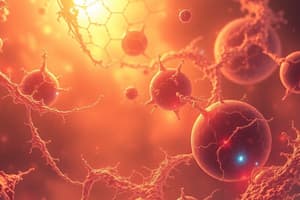Podcast
Questions and Answers
What is the primary disadvantage of using IDMS for urea measurement?
What is the primary disadvantage of using IDMS for urea measurement?
It is not specific for creatinine and is affected by interferences.
Why should specimens for urea measurement not be contaminated with ammonium salts?
Why should specimens for urea measurement not be contaminated with ammonium salts?
Contamination can lead to the conversion of urea to ammonia, skewing results.
What is the effect of prolonged standing on urea samples?
What is the effect of prolonged standing on urea samples?
Prolonged standing causes urea to decompose into ammonia, affecting the accuracy of measurements.
What types of specimens are recommended for accurate urea measurement?
What types of specimens are recommended for accurate urea measurement?
How do fluoride and citrate affect urease enzyme activity?
How do fluoride and citrate affect urease enzyme activity?
Why is a fasting sample usually not required for urea assessment?
Why is a fasting sample usually not required for urea assessment?
What method can be applied to eliminate interferences in the urea measurement?
What method can be applied to eliminate interferences in the urea measurement?
What is the relationship between a protein-rich diet and urea levels?
What is the relationship between a protein-rich diet and urea levels?
How does mass spectrometry contribute to the assessment of urea and creatinine?
How does mass spectrometry contribute to the assessment of urea and creatinine?
What precautions should be taken when preparing samples for urea and creatinine measurement?
What precautions should be taken when preparing samples for urea and creatinine measurement?
What is the significance of measuring urea levels in clinical chemistry?
What is the significance of measuring urea levels in clinical chemistry?
Describe the role of ammonia in metabolism and how its levels are regulated.
Describe the role of ammonia in metabolism and how its levels are regulated.
What are liver function tests and what do they evaluate?
What are liver function tests and what do they evaluate?
Explain the importance of creatinine assessment in clinical diagnostics.
Explain the importance of creatinine assessment in clinical diagnostics.
What is mass spectrometry and its application in medical technology?
What is mass spectrometry and its application in medical technology?
How does the Nelson Somogyi method detect reducing sugars?
How does the Nelson Somogyi method detect reducing sugars?
What is the principle of the condensation method for glucose determination?
What is the principle of the condensation method for glucose determination?
What is unique about the Ortho-Toluidine method in glucose measurement?
What is unique about the Ortho-Toluidine method in glucose measurement?
What is the primary method for measuring urea in clinical scenarios?
What is the primary method for measuring urea in clinical scenarios?
How does ammonia metabolism contribute to urea synthesis in the liver?
How does ammonia metabolism contribute to urea synthesis in the liver?
What is assessed during liver function tests relevant to nitrogen metabolism?
What is assessed during liver function tests relevant to nitrogen metabolism?
What is the significance of creatinine assessment in evaluating renal function?
What is the significance of creatinine assessment in evaluating renal function?
How can mass spectrometry be applied in the context of non-protein nitrogenous substances?
How can mass spectrometry be applied in the context of non-protein nitrogenous substances?
What role do dietary proteins play in the concentration of urea in plasma?
What role do dietary proteins play in the concentration of urea in plasma?
Why is urea considered a major end product of protein metabolism?
Why is urea considered a major end product of protein metabolism?
What clinical implications arise from a significant increase in urea levels?
What clinical implications arise from a significant increase in urea levels?
Flashcards are hidden until you start studying
Study Notes
Isotope Dilution/Mass Spectrometry (IDMS)
- IDMS is recognized as the gold standard reference method due to its accuracy, albeit at a high cost.
- Solutions should be freshly prepared to prevent the conversion of picric acid to picramic acid.
Specimen Considerations
- Recommended specimens include plasma, serum, or urine.
- Non-hemolyzed samples are ideal to minimize errors.
- Protein-rich diets can falsely increase test results; however, the impact of a recent protein meal is generally minor.
- Fasting samples are not typically required.
Inhibitory Factors
- Urease enzyme activity can be inhibited by fluoride and citrate.
- Contamination from ammonium salts must be avoided to prevent ammonia formation.
- Prolonged standing can lead to urea decomposition into ammonia, skewing results.
- Urine and timed urine samples should be refrigerated if not analyzed within a few hours.
Urea Overview
- Urea is the major end product of protein metabolism, with 90% excreted and 10% reabsorbed.
- It is the first marker to increase in renal diseases.
- The liver synthesizes urea from CO2 and ammonia through the urea/Kreb's cycle.
- Urea concentration in plasma serves as an indicator of renal function, protein intake, and protein metabolism levels.
Carbohydrates Testing Methods
- Various methods assess reducing sugars, such as:
- Nelson Somogyi Method: Highly sensitive and specific; color disappearance is measured at 400 nm.
- Neocuproine Method: Involves reaction with copper to analyze sugars.
- Condensation Method: Forms colored derivatives through the reaction between glucose aldehyde groups and aromatic amines in hot acetic acid.
- Benedict’s Method: Modified from Folin Wu, detects and quantifies reducing sugars.
General Precautions
- A thorough understanding of specimen handling and testing methodology is crucial to ensure accuracy and reliability of results.
- Avoiding interferences through proper sample preparation enhances method specificity and sensitivity.
Studying That Suits You
Use AI to generate personalized quizzes and flashcards to suit your learning preferences.




